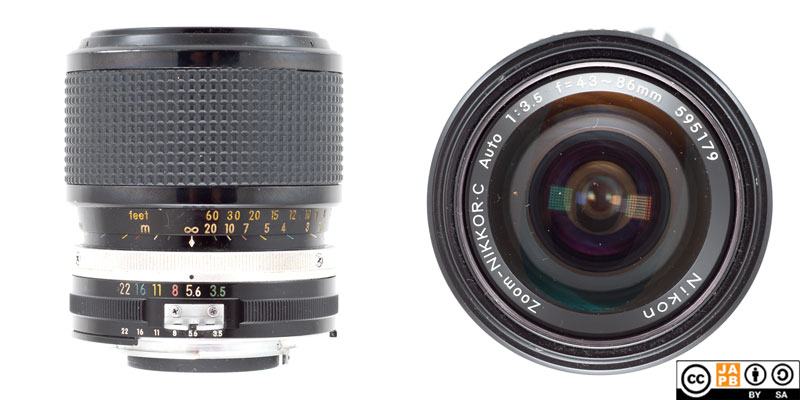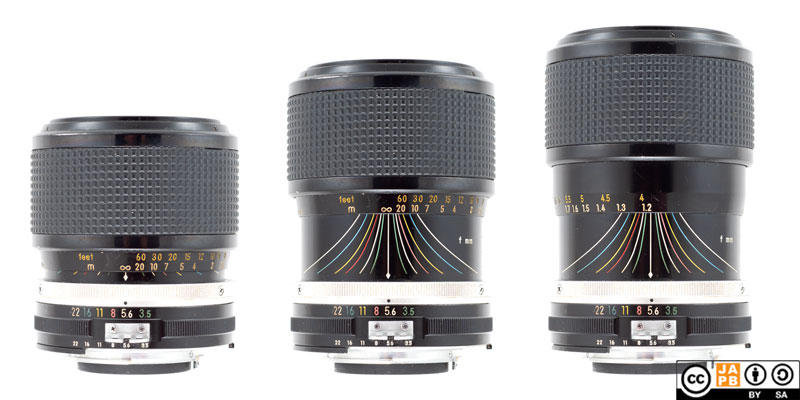Pekka Buttler, 12/2023

Specifications
The table below summarizes the lens’ key specifications (measurements based on pictured sample):
| Brand: | Nikon | Lens name | Zoom-NIKKOR•C Auto 1:3.5 f=43~86mm |
| Focal length(s)1 | 43-86 mm | Angle-of-view2 | 53°–28°30 |
| Maximum Aperture | f/3.5 | In Production | 1974–1976 (this version) 1963–1982 (all versions) |
| Lens mount | Nikon F | Subfamily (if applicable) | C-type (Pre-Ai) |
| Length3 | 70,3 mm | Diameter4 | 65,2 mm |
| Filter ring diameter | 52 mm | Weight | 411 grams |
| Lens element count | 9 | Lens group count | 7 |
| Aperture blades (S/R/C)5 | 6 S | Focus throw | 170 ° |
| Minimum focusing distance | 1,2 m | Maximum magnification | 1:12 |
| Has manual aperture ring | YES | Has Manual focus ring | YES |
Further notes:
This is the earlier version of the well-known (some would say: notorious) Nikkor 43–86mm design (see version history below).
• It is a one-ring (push-pull) design, where you push forward to zoom in.
• The lens lengthens considerably while zooming, and – again – while focusing. The entire front (including filter threads) of the lens rotates when focusing.
• While covering normal to short tele focal lengths, the lens’ usability as a portrait lens is somewhat limited by its rather long minimum focusing distance.
• Nikon did not offer a specialised lens hood, but rather suggests using the HN-3 lens hood (which is used on most manual-era 35 mm primes). That hood’s efficacy at closer to 86 mm focal length is likely limited.

Middle: Nikkor C 43-86 mm f/3.5, zoomed to 36, focused to infinity
Left: Nikkor C 43-86 mm f/3.5, zoomed to 36, focused to MFD
A brief genealogy of Nikon SLR lens types
Nikon is undoubtedly one of the great names in 35 mm SLR photography. The Nikon F mount has been in continuous production since 1959. During that time, the mount has developed/changed in some detail, however without ever fully sacrificing compatibility.
In short (a longer version is here), the development of Nikon’s SLR lenses can be traced as follows:
• 1959–1977: Pre-Ai. Manual focus lenses that use ‘rabbit ears’ to communicate selected aperture with the camera body. Pre-Ai lenses can further be subdivided into
• F-type (1959–early 1970s: metal focus ring and single-coated),
• C-type (early 1970s–mid 1970s: metal focus ring and multicoated), and
• K-type (mid 1970s to 1977: rubber focus ring and multicoated).
A significant share of remaining Pre-Ai lenses have since been converted to Ai-spec (Ai’d)
• 1977–1986: Ai and Ai-s. Manual focus lenses that may have ‘rabbit ears’ for backward compatibility, but are designed to communicate selected aperture with the camera body through indentations in base of aperture control ring.
• 1986–today: AF and AF-D. Autofocus lenses that do not have a focusing motor within the lens, but rely on the focus motor within the camera. All AF and AF-D lenses are simultaneously Ai-s lenses (they are Ai-s lenses extended with AF) 6
• 1996–today AF-S and AF-P. Autofocus lenses that have an internal focusing motor and do not rely on the body having a focusing motor.
Version history
The first version of the Zoom-Nikkor 43-86/3.5 was introduced in 1963, only 4 years after the 1959 introduction of the Voigtländer zoomar (widely credited to be the first zoom for still cameras). This was so early in the development of zoom lenses, that Nikon (back then: Nippon Kogaku) clearly did not know how to name its newfangled marvel. It was hence named the Zoom-NIKKOR Auto 1:3.5 f=43mm~86mm.
While certainly being the first Japanese compact zoom, and while introducing the photographing masses to the concept of zooms, it did suffer issues. To quote a rather boisterous pundit:
“The original Nikon 43-86mm is the worst lens Nikon has ever made.
It’s worse than the worst, because not only is it terrible by itself, it was so awful that it has tainted the reputation of all other zoom lenses to this day.” (Source, emphasis added)
The ‘original’ 43-86 came in two iterations:
• An F-type (1963-1974), with a 9 elements in 7 groups design and a 6-bladed aperture, weighing 410 grams,
• A C-type; (1974–1976) which was otherwise similar but multicoated [this lens]
The ‘second’ 43–86 likewise came in two iterations
• A K-type (1975–1977), with a 11 elements in 8 groups design and a 7-bladed aperture weighing 450 grams,
• An Ai version (1977–1982), which was otherwise similar but supported Ai camera bodies [data sheet]
Adapting
There are good chances this lens can still be used natively:
• If the lens has been AI’d, this lens can be used natively on all current high-end Nikon dSLRs and several earlier medium-to-high-end older Nikon dSLRs7 as well as all post-1977 Nikon Film cameras.
• If it is in its original Pre-Ai form, it can be used natively on the Nikon Df and on all Nikon F-mount film cameras produced before 1977.
Thanks to being a fully manual lens (manual aperture, manual focus), the lens can be adapted to all mirrorless cameras using a suitable dumb adapter (and such adapters are easy to find). Moreover, a large range of special adapters (helicoid adapters, tilt/shift adapters, speed boosters) for using Nikon F lenses on most mirrorless systems are available.
Using Nikon F lenses on non-Nikon SLRs and dSLRs is likewise a distinct possibility. Thanks to the relatively generous flange focal distance of the Nikon F mount (46,5 mm), adapter rings for all dSLR mounts are available as well as for a goodly portion of film-era SLR mounts. Such rings may not allow for auto aperture, but even then the lenses can be used in stop-down metering mode.
Footnotes
1 Focal length is (unless stated otherwise) given in absolute terms, and not in Full-frame equivalent. For an understanding of whether the lens is wide/tele, see ‘Angle-of-view’.
2 Picture angle is given in degrees and concerns the diagonal picture angle. Rule of thumb:
> 90 ° ==> Ultra-wide-angle
70–90 ° ==> Wide-angle
50–70 ° ==> Moderate wide-angle
40–50 ° ==> ‘Standard’ or ‘normal’ lens
20–40 ° ==> Short tele lens
10-20 ° ==> Tele lens
5-10 ° ==> Long tele lens
< 5 ° ==> Ultra-tele lens
3 Length is given from the mount flange to the front of lens at infinity.
4 Diameter excludes protrusions such as rabbit ears or stop-down levers.
5 S=straight; R=rounded; C=(almost)circular at all apertures.
6 There is a further sub-class of AF-D lenses called AF-I lenses that are otherwise AF-D lenses (meaning, fully Ai-s compatible), but have an internal focus motor. Only long tele lenses were made in AF-I variants.
7 As of this writing, the following Nikon dSLRs fully support Aperture priority and manual metered modes on Nikkor Ai lenses: D2, D3, D4, D5, D6, D200, D300, D300s, D500, D600, D610, D700, D750, D780, D800, D800E, D810, D850, D7000, D7100, D7200